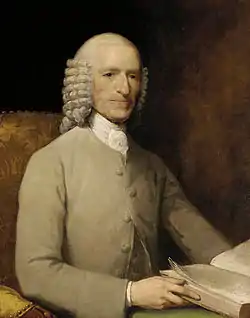John Fothergill (physician)
John Fothergill FRS (8 March 1712 – 26 December 1780) was an English physician, plant collector, philanthropist and Quaker. His medical writings were influential, and he built up a sizeable botanic garden in what is now West Ham Park in London.

Life and work
Fothergill was born at Carr End, near Bainbridge in Yorkshire, the son of John Fothergill (1676–1745), a Quaker preacher and farmer, and his first wife, Margaret Hough (1677–1719).[1] After studying at Sedbergh School, Fothergill was apprenticed to an apothecary. In 1736, he obtained the degree of Doctor of Medicine at Edinburgh and followed this by further studies at St Thomas's Hospital, London. After visiting continental Europe in 1740, he settled in London, where he gained an extensive practice. During the influenza epidemics of 1775 and 1776 he is said to have treated 60 patients a day.[2]
In 1745, Fothergill gave a brief lecture to the Royal Society of London, citing the work of a Scottish physician and surgeon, William Tossach (c. 1700–1771). This is the first known lecture on the practice of mouth-to-mouth ventilation. He is also credited with first identifying and naming trigeminal neuralgia in his work Of a Painful Affection of the Face in 1773.[3]
Fothergill's pamphlet Account of the Sore Throat attended with Ulcers (1748) contains one of the first descriptions of streptococcal sore throat in English and was translated into several languages.[2] His rejection of ineffective traditional therapies for the disease saved many lives.[1] He also supported the publication of Benjamin Franklin's papers on electricity and wrote a preface to them.[4]
Botanist and Quaker
In his leisure time, John Fothergill made a study of conchology and botany.[2] In 1762 he bought Upton House near Stratford, London, where he built up an extensive botanical garden and grew many rare plants obtained from various parts of the world (now West Ham Park).[1] In the garden, with its glasshouses, John Coakley Lettsom (1744–1815), a Quaker physician and a protégé of his, exclaimed that "the sphere seemed transposed, as the Arctic Circle joined with the equator".[5] Lettsom published a catalogue of the plants of Fothergill's garden Hortus Uptonensis, or a catalogue of the plants in the Dr Fothergill's garden at Upton, at the time of his decease anno 1780. Fothergilla is named in his honour.[6] The standard author abbreviation Foth. is used to indicate this person as the author when citing a botanical name. He was elected a Fellow of the Royal Society in 1763 and became a member of the American Philosophical Society in 1770.[7]
Fothergill was the patron of Sydney Parkinson, the South Sea voyager, and of William Bartram, the American botanist in his southern travels of 1773–1776. A translation of the Bible, known as the Quaker Bible, made by Anthony Purver, was fashioned and printed at his expense. He founded Ackworth School, Pontefract, Yorkshire in 1779.[8]
John Fothergill died in London on 26 December 1780, aged 68, of urinary retention perhaps linked with prostate cancer. Fanny Burney, having earlier described him as "an upright, stern old man... an old prig," later recorded when she was his patient: "He really has been... amazingly civil and polite to me... as kind as he is skilful." His niece Betty Fothergill described him in her journal as "surely the first of men. With the becoming dignity of age he unites the cheerfulness and liberality of youth. He possesses the most virtues and the fewest failings of any man I know".[1]
See also
Notes
- DeLacy 2007.
- Chisholm 1911, p. 733.
- Pearce, J. M. S. (2003). "Trigeminal neuralgia (Fothergill's disease) in the 17th and 18th centuries". Journal of Neurology, Neurosurgery & Psychiatry. 74 (12): 1688. doi:10.1136/jnnp.74.12.1688. PMC 1757428. PMID 14638891.
- The Autobiography of Benjamin Franklin
- Coats 1992, "Clematis" cites Lettsom 1786
- Gledhill, David (2008). "The Names of Plants". Cambridge University Press. ISBN 9780521866453 (hardback), ISBN 9780521685535 (paperback). pp 169
- Society site.
- "History of Ackworth School, a UK Boarding School". www.ackworthschool.com. Retrieved 6 February 2018.
References
- DeLacy, Margaret (October 2007) [2004]. "Fothergill, John (1712–1780)". Oxford Dictionary of National Biography (online ed.). Oxford University Press. doi:10.1093/ref:odnb/9979. (Subscription or UK public library membership required.)
- Coats, Alice M. (1992) [1964]. "Clematis". Garden Shrubs and their Histories.
- Lettsom, John Coakley (1786). Memoires of John Fothergill, M.D.
- "John Fothergill". Dictionary of medical eponyms (Whonamedit). Retrieved 6 February 2017.
Attribution
 This article incorporates text from a publication now in the public domain: Chisholm, Hugh, ed. (1911). "Fothergill, John". Encyclopædia Britannica. 10 (11th ed.). Cambridge University Press. p. 733.
This article incorporates text from a publication now in the public domain: Chisholm, Hugh, ed. (1911). "Fothergill, John". Encyclopædia Britannica. 10 (11th ed.). Cambridge University Press. p. 733.
Further reading
| Wikimedia Commons has media related to John Fothergill (physician). |
| Wikisource has the text of the 1885–1900 Dictionary of National Biography's article about Fothergill, John (1712-1780). |
- Fothergill, John; Elliot, John (1781). A Complete Collection of the Medical and Philosophical Works of John Fothergill. London: John Walker.
John Fothergill.
- Bernet, Claus (2010). "John Fothergill (physician)". In Bautz, Traugott (ed.). .shtml Biographisch-Bibliographisches Kirchenlexikon (BBKL) Check
|url=value (help) (in German). 31. Nordhausen: Bautz. cols. 456–464. ISBN 978-3-88309-544-8. - Fothergill, Samuel; Crosfield, George (1843). Memoirs of the Life and Gospel Labours of Samuel Fothergill, with Selections from his Correspondence. London: D. Marples.
fothergill.
contains information on John Fothergill, the author's father - Harvey, Karen, ed. (2005). The Kiss in History. Manchester: Manchester University Press. ISBN 9780719065958. – See Chapter 5: Davidson, Luke, The kiss of life in the eighteenth century: the fate of an ambiguous kiss.
- Fox, Richard Hingston (1919). Dr. John Fothergill and his friends; chapters in eighteenth century life. London: Macmillan.